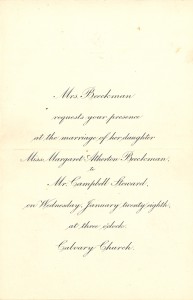 My grandfather once told me that his parents had to wait for several years to marry. When they did, in January 1885, my great-grandfather was 32 and his bride 23 – hardly old by our standards, perhaps! My grandfather’s box of family papers yields a copy of the wedding invitation; even better, another envelope contains the tiny (2 5/8” by 4”) notebook in which my great-grandmother listed her wedding presents. Continue reading A wedding at a glance
My grandfather once told me that his parents had to wait for several years to marry. When they did, in January 1885, my great-grandfather was 32 and his bride 23 – hardly old by our standards, perhaps! My grandfather’s box of family papers yields a copy of the wedding invitation; even better, another envelope contains the tiny (2 5/8” by 4”) notebook in which my great-grandmother listed her wedding presents. Continue reading A wedding at a glance
Tag Archives: Family papers
Orphan trains
 I received a phone call the other day from my parents as they were driving through Kansas on a road trip. They wanted to tell me about a curious roadside advertisement they had seen that they thought would interest me: the National Orphan Train Complex in Concordia, Kansas. I had never heard of this museum, let along its subject, so I decided to do some sleuthing. What I discovered was an intriguing, controversial, and apparently slightly obscure facet of American history. Continue reading Orphan trains
I received a phone call the other day from my parents as they were driving through Kansas on a road trip. They wanted to tell me about a curious roadside advertisement they had seen that they thought would interest me: the National Orphan Train Complex in Concordia, Kansas. I had never heard of this museum, let along its subject, so I decided to do some sleuthing. What I discovered was an intriguing, controversial, and apparently slightly obscure facet of American history. Continue reading Orphan trains
Leaving their mark
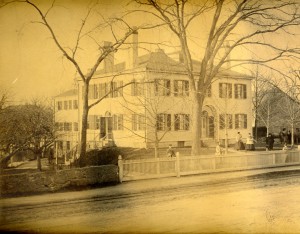 A few months ago, my husband and I moved to Dorchester, Massachusetts, to work as caretakers of the William Clapp house, which was built in 1806. William Clapp and his wife, Elizabeth (Humphreys) Clapp, were married in the parlor of this house on 15 December 1806. They had nine children, two of whom died at a young age. This family also suffered the loss of three more children in November of 1838 from typhoid fever. Rebecca Clapp, aged twenty, and James Clapp, aged nineteen, died on the same day, and their brother Alexander Clapp, aged seventeen, died four days later. Continue reading Leaving their mark
A few months ago, my husband and I moved to Dorchester, Massachusetts, to work as caretakers of the William Clapp house, which was built in 1806. William Clapp and his wife, Elizabeth (Humphreys) Clapp, were married in the parlor of this house on 15 December 1806. They had nine children, two of whom died at a young age. This family also suffered the loss of three more children in November of 1838 from typhoid fever. Rebecca Clapp, aged twenty, and James Clapp, aged nineteen, died on the same day, and their brother Alexander Clapp, aged seventeen, died four days later. Continue reading Leaving their mark
A price beyond rubies
 In 2010, I visited the town of Rose in Cumberland County, Nova Scotia, to meet the nieces and nephew of Ada Lophemia (Halliday) Clark. Ada was the second wife of my great-grandfather Thomas William Clark of Moncton, New Brunswick. Within the walls of their ancestral home in Rose I heard stories of a great-grandfather who died more than a quarter-century before I was born, a man that my own father only mentioned by name, and whose face is still unknown to me. No photograph is known to exist of my great-grandfather. Nonetheless, through genealogical research and family stories I have been able to draw a picture of what he was like, with a rough sense of his life story. Continue reading A price beyond rubies
In 2010, I visited the town of Rose in Cumberland County, Nova Scotia, to meet the nieces and nephew of Ada Lophemia (Halliday) Clark. Ada was the second wife of my great-grandfather Thomas William Clark of Moncton, New Brunswick. Within the walls of their ancestral home in Rose I heard stories of a great-grandfather who died more than a quarter-century before I was born, a man that my own father only mentioned by name, and whose face is still unknown to me. No photograph is known to exist of my great-grandfather. Nonetheless, through genealogical research and family stories I have been able to draw a picture of what he was like, with a rough sense of his life story. Continue reading A price beyond rubies
Shoes in the attic
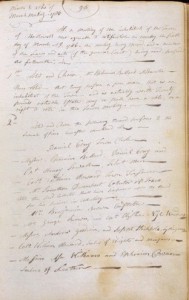
When Chicken Little said the sky was falling, I did not take that to mean corsets and shoe lasts. I’ve learned while restoring and renovating my old house that the unexpected is to be expected, that making a change here means a ripple effect of changes there, and that what goes up must come down, usually when I’m not expecting it.
When our carpenters were working on the original back staircase, everything seemed to fall out of the old ceiling: square hand-cut nails, buttons, a hand-cut wooden spoon, a wooden shoe last, some small bones I’d rather not discuss, but not one bag of Colonial-era coin, no now-priceless daily diaries. Continue reading Shoes in the attic
Family plots: Part Two
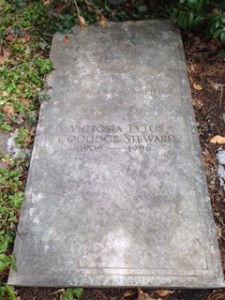 Riffing on something Chris Child wrote about collecting photos of family members in July, I thought I might do something similar with information about family burial plots. Such an exercise leans heavily on Findagrave.com (where some of the images may be found), although in my case I also have the notes compiled by my great-aunt Margaret Steward in 1966 as a resource for my research.
Riffing on something Chris Child wrote about collecting photos of family members in July, I thought I might do something similar with information about family burial plots. Such an exercise leans heavily on Findagrave.com (where some of the images may be found), although in my case I also have the notes compiled by my great-aunt Margaret Steward in 1966 as a resource for my research.
My grandparents are easy: my father’s parents (and stepmother) are buried at Hamilton Cemetery in Massachusetts, while my mother’s parents (and stepmother) are buried at Arlington National Cemetery in Virginia. I was present for my paternal grandfather’s memorial service in 1991, my maternal grandfather’s burial in 1994, and for my paternal step-grandmother’s memorial service in 1996. Continue reading Family plots: Part Two
The introduction of photography

Perhaps more than any other event, the introduction of photography altered how individuals were memorialized and are remembered. While portraits have been produced for thousands of years, photographic images were first introduced about 1838 and the first known photograph to contain people was produced between April and May of that year.[1] This photograph is of the Boulevard du Temple in Paris, and due to the long exposure time of about ten to twelve minutes, all people in the photograph moved and avoided being captured in the image, with the exception of a man having his shoes shined who remained still for the length of the exposure.[2] Continue reading The introduction of photography
Delayed recording of deeds

While working on the Early New England Families Study Project sketch on Samuel Maverick this week, I came across a deed from 1636 that was not recorded until 1717! This is a good reminder that deeds are entered into the official books by the date they were recorded, not by the date they were made. Thus, one can never assume that a deed recorded after a person’s death – even decades after – is not that person’s deed.
A sale of land was legal, whether or not the deed was recorded, although recording the transaction helped to prove legality if disputed. Recording might be delayed until the land was sold the next time, which might be a generation or two later. Continue reading Delayed recording of deeds
Mrs. Gray on marriage
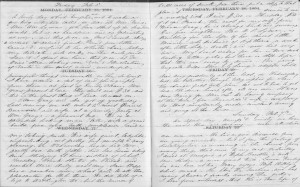
Regina Shober Gray’s diary abounds in telling details and contemporary gossip; in some ways, her views on the marriages (and marriage prospects) of her friends call out some of her choicest phrasing:
Boston, ca. Sunday, 5 January 1873: Our cousin John C. Gray, jr.[1]’s engagement to Nina Mason (daughter of the late Rev. Charles M.[2]) was announced yesterday. She is 19 – he 33 or 34, a great difference at her age. On dit[3] he fell very desperately in love with her when travelling in Europe – and that her mother would not consent to any engagement till the child had seen at least one year of home society, thinking very naturally Nina was too young & inexperienced to know her own mind.
Sunday, 19 January 1873: Poor young Nellie U[4]’s miserable entanglement with Charles Walker has come to a crisis at last, after having been town talk for more than two years; and in all that time, no whisper or suspicion has reached her parents’ ears. Continue reading Mrs. Gray on marriage
“Free access”
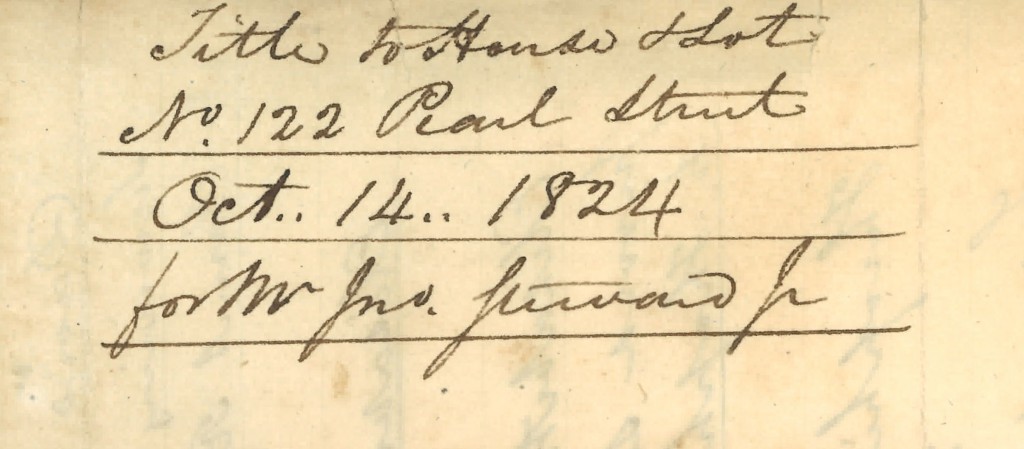 It was a matter of some pride to my grandfather that his great-grandfather John Steward (1777–1854) bought the (downtown) Gracie Mansion[1] when he moved to New York more than two hundred years ago. Perhaps so, as John Steward lived at 1 Pearl Street until he moved far uptown to a new house at Fifth Avenue and Twenty-first Street, shortly before his death in 1854. The title abstracts in my grandfather’s box of family papers concerning John’s Pearl Street real estate are for some other properties – one was his store, at 80 Pearl Street,[2] while another (122 Pearl Street) was purchased from Mr. and Mrs. Charles McEvers. Continue reading “Free access”
It was a matter of some pride to my grandfather that his great-grandfather John Steward (1777–1854) bought the (downtown) Gracie Mansion[1] when he moved to New York more than two hundred years ago. Perhaps so, as John Steward lived at 1 Pearl Street until he moved far uptown to a new house at Fifth Avenue and Twenty-first Street, shortly before his death in 1854. The title abstracts in my grandfather’s box of family papers concerning John’s Pearl Street real estate are for some other properties – one was his store, at 80 Pearl Street,[2] while another (122 Pearl Street) was purchased from Mr. and Mrs. Charles McEvers. Continue reading “Free access”